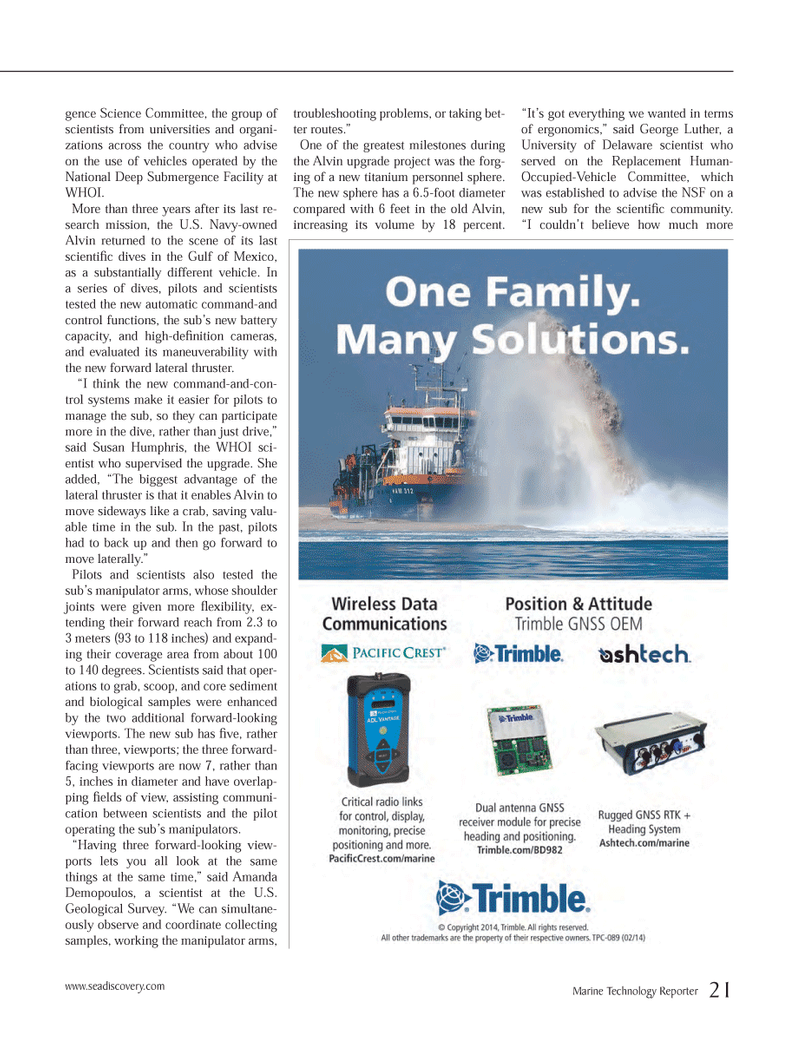
Page 21: of Marine Technology Magazine (April 2014)
Offshore Energy
Read this page in Pdf, Flash or Html5 edition of April 2014 Marine Technology Magazine
gence Science Committee, the group of scientists from universities and organi- zations across the country who advise on the use of vehicles operated by the
National Deep Submergence Facility at
WHOI.
More than three years after its last re- search mission, the U.S. Navy-owned
Alvin returned to the scene of its last scientifi c dives in the Gulf of Mexico, as a substantially different vehicle. In a series of dives, pilots and scientists tested the new automatic command-and control functions, the sub’s new battery capacity, and high-defi nition cameras, and evaluated its maneuverability with the new forward lateral thruster. “I think the new command-and-con- trol systems make it easier for pilots to manage the sub, so they can participate more in the dive, rather than just drive,” said Susan Humphris, the WHOI sci- entist who supervised the upgrade. She added, “The biggest advantage of the lateral thruster is that it enables Alvin to move sideways like a crab, saving valu- able time in the sub. In the past, pilots had to back up and then go forward to move laterally.”
Pilots and scientists also tested the sub’s manipulator arms, whose shoulder joints were given more fl exibility, ex- tending their forward reach from 2.3 to 3 meters (93 to 118 inches) and expand- ing their coverage area from about 100 to 140 degrees. Scientists said that oper- ations to grab, scoop, and core sediment and biological samples were enhanced by the two additional forward-looking viewports. The new sub has fi ve, rather than three, viewports; the three forward- facing viewports are now 7, rather than 5, inches in diameter and have overlap- ping fi elds of view, assisting communi- cation between scientists and the pilot operating the sub’s manipulators. “Having three forward-looking view- ports lets you all look at the same things at the same time,” said Amanda
Demopoulos, a scientist at the U.S.
Geological Survey. “We can simultane- ously observe and coordinate collecting samples, working the manipulator arms, troubleshooting problems, or taking bet- ter routes.”
One of the greatest milestones during the Alvin upgrade project was the forg- ing of a new titanium personnel sphere.
The new sphere has a 6.5-foot diameter compared with 6 feet in the old Alvin, increasing its volume by 18 percent. “It’s got everything we wanted in terms of ergonomics,” said George Luther, a
University of Delaware scientist who served on the Replacement Human-
Occupied-Vehicle Committee, which was established to advise the NSF on a new sub for the scientifi c community. “I couldn’t believe how much more
Marine Technology Reporter 21 www.seadiscovery.com
MTR #3 (18-33).indd 21 4/9/2014 9:45:34 AM

 20
20

 22
22
